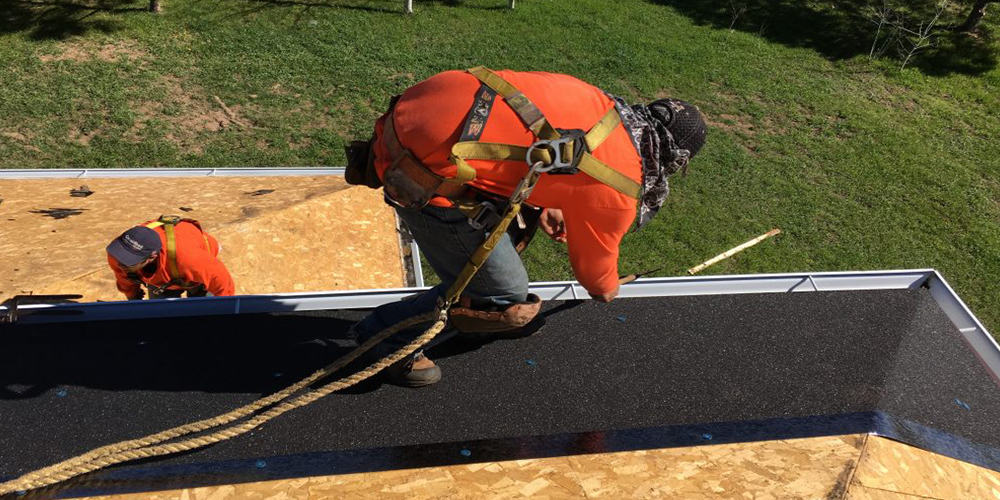Considering our mild weather, and both abundant sunshine and hail storm damaged roofs installing asphalt shingles during the upcoming Winter season will occur. This may not be the easiest season to coordinate roof installs in Colorado Springs, yet in this season it will be a necessity. In this post we will consider several weather variables and take a peak at our installers perspectives. Before we dive into this information let’s explore shingle manufacturers information regarding cold weather installation of asphalt shingles. Click here to see one of our YouTube videos regarding cold weather installs.
Many shingle manufacturers are hesitant and wisely avoid giving magic formulas for winter installations. Certainly everyone roofing Colorado Springs homes with asphalt shingles during the Winter needs to pay serious attention to the weather. The manufacturers biggest concern in low temperature environments is the possibility of the adhesive strip non activating due to low roof surface temperatures. So one would ask, “What is the minimum temperature that shingles can be installed?” The answer to this question is somewhat complex in nature. We’ll begin with the answer that we get from manufacturers, chemist and product engineers at shingle manufacturing facilities. Every time I tour a facility I always ask this question and the answer is always the same. We can’t give an exact temperature, but a good rule of thumb is forty degree fahrenheit on the roofs surface.
The ambient temperature can be colder while the roof surface is 40 degrees. One of the benefits of installing shingles in the Winter in Colorado Springs is the abundant sunshine. The suns radiant energy is of significant importance in heating the roof surface to a minimum of forty degrees in the Winter. Again, 40 degrees is not a magic number nor is it concrete, it’s a safe temperature for installing shingles. I’ve been skiing in Breckenridge and other ski resorts and I’ve seen roofers installing shingles in temperatures just a little above zero degrees. Integrity Roofing and Painting, LLC will not install shingle when it’s that cold. Any contractor that has been roofing Colorado Springs for some time knows that roofs can be installed with an ambient temperature as low as 30 degrees. As a matter of fact we’ve seen some roofers in Colorado Springs installing roofs in the snow in temps as low as 20 degrees. We do not recommend installing shingles in the snow. I certainly don’t know the circumstances of that install. Maybe they had a real estate closing so I’m not going to judge a roofer for installing asphalt shingles in poor conditions.
Ideally asphalt shingle should be installed when the air temperature is above 30 degrees with an abundance of sunshine. Colorado Springs roofing contractors should install shingles when possible in direct sunlight. This will help activate the self adhesive sealant strips on the back of the shingle. This is extremely important for long term performance all of the strips should adhere to the underlying shingle. When the self sealing strips on asphalt shingles do not activate within a few days or weeks dust and debris may blow underneath of the shingles and prevent any possibility of these asphalt shingles from sealing. If you were able to capture what i’m saying than you’ll realize that many shingles that are installed in the Winter may not seal on the day of the install. That is perfectly fine when multiple factors are taken into consideration.
As long as the shingles seal before a long period of high winds occur forcing dust and debris in between the sealant strip and the adjoining shingle than everything will be fine. Many roofs are installed in the Winter and within a couple weeks all of the adhesive strips have activated and solidified the mass of shingles into one large unit. Installing asphalt shingles in the Winter is an acceptable practice for all roofing companies Colorado Springs has to offer. There are roofers in other states that really push the envelope with cold weather installations. Most Colorado Springs roofing companies are cautious and use common sense principles and techniques for cold weather application of asphalt shingles.
Homeowners need to be aware that asphalt shingles when installed in the Winter will look bumpy and wavy on the roof. In the Winter the asphalt shingles are less malleable and will reflect the shape of the shingles when they are packaged, bundled and stacked on the roof. It may take several months of radiant heat for the shingles to lay down flat on the roofs surface. This is standard and it will not impact the serviceability or performance of the shingle. There is a slight possibility that some of the shingles asphalt sealant strips may not bond to the next shingle. If this happens to a few shingles here and there you will not have an issue. However, if this were to occur in large sections on the roof than these shingles will need to be sealed.
Shingle manufacturers warranties only cover re-sealing shingles when the asphalt sealant doesn’t bond shingles together. At this point a roofing technician will gently lift up the affected shingles and apply small dabs of plastic cement underneath of the shingles than gentle pressure will be applied downward to bond the shingles together. If the shingle manufacturers say that this is the proper way to repair the temporary issue than you can trust that this will bring quick resolution to bonding the shingles together.
There are many roofing companies in Colorado Springs that install 6-nails per shingle which is the best roofing practice for our area. While technically stating six nails per shingle the reality is twelve nails are being installed per shingle. When installing this many nails per shingle even if in a few areas the adhesive doesn’t activate you’ll have more than enough nails to keep the shingles in place. Occasionally as I drive through neighborhoods I’ll see a few shingles missing on roofs and I don’t know if those roofs were installed in the Winter or if there an insufficient number of nails. Rarely do I ever see large areas of shingles missing on roofs that were blown off during a wind storm. Overall we see no issue with installing asphalt shingles during the Winter as long as the roofer exercises normal roofing protocol everything will be okay.
Remember that the shingles will look bumpy, wavy or some may even say they look wrong when the asphalt shingles are cold. I agree, they will look that way until they are heated up enough to a point where the asphalt becomes malleable and the weight of the shingles and gravity forces them to lay flat on the roofs surface. This may take up to several months. Patience and trust is required on the part of the homeowner for the asphalt shingles will eventually lay flat on the roof. If you’re not willing to have this temporary appearance than your roof will need to be installed in warmer weather.
If the ground has snow than be prepared to find roofing debris in the yard when the snow melts. This is mostly unavoidable, so if you’re willing to accept this inconvenience than having your roof installed in the Winter will work for you. Additional tarps can be laid on the ground to help minimize roof debris in the snow. Overall, if you’re patient and understanding than having a roof installed in the Winter may work out for you. You’ll have to decide if this is right for you. Personally, we see very few issues with cold weather application of shingles. The issue that we see and experience is that it’s cold on our fingers, but we’re tough, so let’s get roofing.

